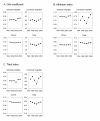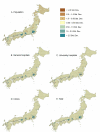Trend in geographic distribution of physicians in Japan
- PMID: 19257879
- PMCID: PMC2662844
- DOI: 10.1186/1475-9276-8-5
Trend in geographic distribution of physicians in Japan
Abstract
Background: Since the late 1980s, the policy of the Japanese government regarding physician manpower has been to decrease the number of medical students. However, the shortage of doctors in Japan has become a social problem in recent years. The aim of this study was to compare the numbers of physicians in Japan between 1996 and 2006 and the trends in distribution of physicians.
Methods: The time trends in number and distribution of physicians between 1996 and 2006 were analyzed. Gini coefficient, Atkinson index and Theil index were used as measures for mal-distribution of physicians to population. The distribution of physicians was visualized on a map by using geographic information system (GIS) software.
Results: The total number of physicians increased every year in the period from 1996 to 2006 but has remained below the international standard. All three measures of mal-distribution of physicians worsened after 2004, and the worsening was remarkable in the distribution of physicians working at hospitals. The number of physicians working at hospitals has significantly increased in urban areas but not in areas with low population densities. When medical interns were excluded from calculation, the measures of mal-distribution improved.
Conclusion: The problem of a doctor shortage in Japan is linked to both the shortage of absolute number of physicians and the mal-distribution of hospital physicians. The new postgraduate internship system might worsen this situation.
Figures



References
-
- Agence Francwe Presse http://afp.google.com/article/ALeqM5i5XP-O252HC9opxHZ6aKgsXRKjqw
-
- The Japan Times http://search.japantimes.co.jp/cgi-bin/ed20071001a1.html
-
- World Health Organization http://www.who.int/whosis/whostat2007/en/index.html
-
- OECD OECD health data 2006
LinkOut - more resources
Full Text Sources
Research Materials

